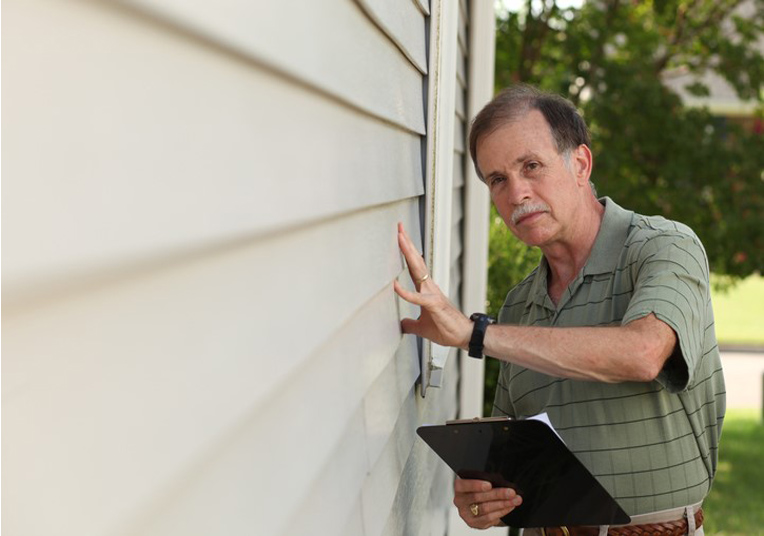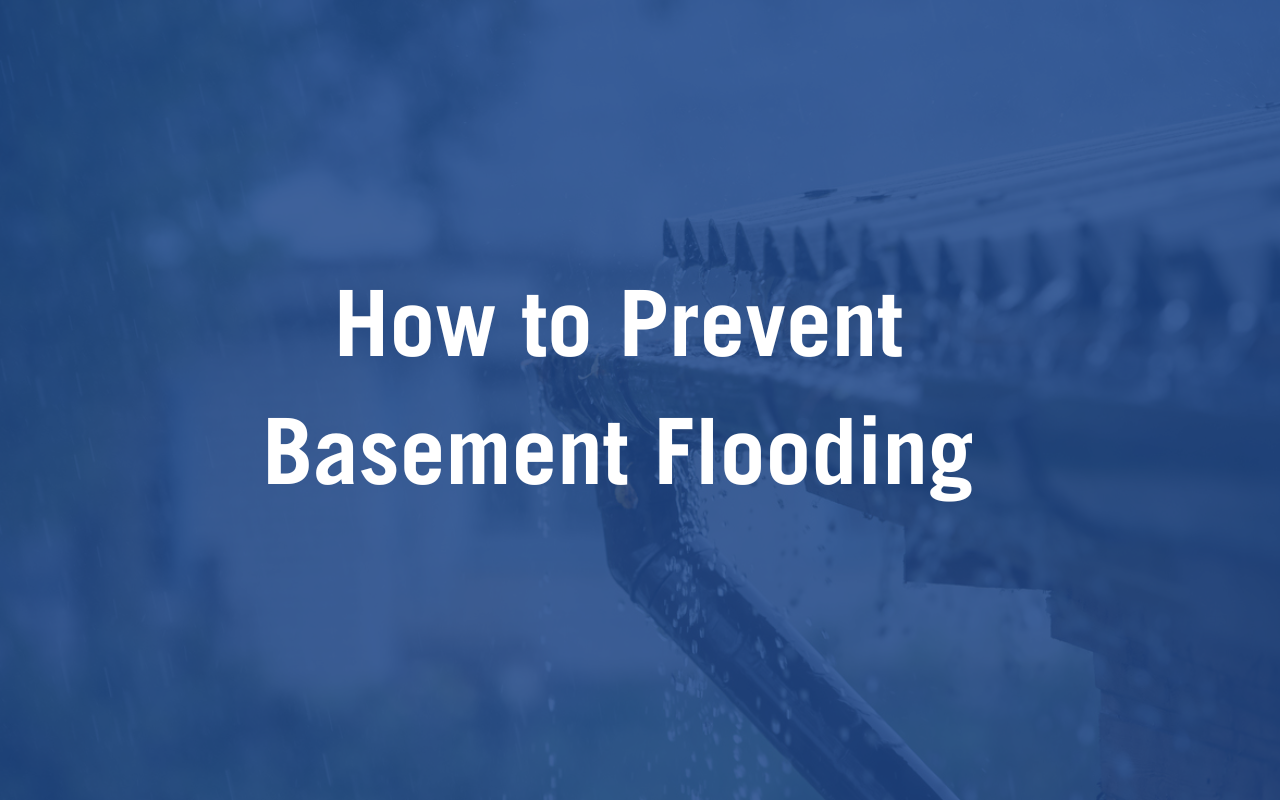Basement flooding is a homeowner’s worst nightmare, right up there with needing a new roof. Flooding impacts walls and floors and can lead to costly damage throughout your home. Understanding how to prevent basement flooding during heavy rain is key to protecting your home for years to come.
If you’re worried about water seeping into your basement after a heavy rain, you’re in the right place. Learn what causes a flood in the basement, what to do if your basement floods, and how to prevent basement flooding in the first place.

Common Reasons For Basement Flooding During Heavy Rain
Understanding the common causes of a flooding basement will equip you with the knowledge and tools to effectively prevent damage to your home. Two broad reasons for basement floods when it rains are poor drainage and an improperly sealed foundation. However, there are other common issues that can lead to problems.
- Poor Foundation Damage: Water will always find a way, even through the smallest cracks and holes in a foundation. Check the interior walls of your basement for signs of damage and seal up any cracks or holes.
- Clogged Gutters and Downspouts: If your gutters or downspouts are clogged, rainwater can pool close to the house and create a basement flood risk.
- Landscaping Problems: The ground surrounding the foundation of your home should slope down so that any excess water naturally drains away from the house. If it slopes towards the house, excess water will flow to your foundation leading to water in the basement after rain.
- Gaps Around Windows: Windows and doors to the basement are common culprits for holes that may be allowing water into the basement after a heavy rain.

10 Ways to Prevent Basement Flooding During Heavy Rain
It can be daunting to fix basement flooding if you are in the thick of dealing with it. But with a few preventative measures now, you can save yourself the headache and money in the long run. Some techniques are simple maintenance and prevention tasks. Others involve waterproofing installations or landscaping projects that can significantly mitigate the risk of water entry and damage.
Early Prevention Techniques
Most of these techniques can be added to your seasonal maintenance checklist to help prevent basement flooding.
Don’t forget about other regular home maintenance items like testing your smoke and carbon monoxide detectors, checking your furnace, and assessing your roof for any leaks, especially if you live in a cold-weather climate.
- Regular Cleaning and Maintenance: Keep your gutters free from old leaves, twigs, and other debris by cleaning them out regularly, even if you have gutter guards. Make sure the water isn’t pooling near the downspouts and use a downspout extender if you notice pools of water near your home.
- Inspecting and Repairing Foundation Cracks: Even if you don’t have visible cracks or holes in the foundation, that doesn’t mean foundation issues aren’t present. Check for uneven or sinking floors, doors that stick, or warped siding. You can fill minor cracks in the foundation with epoxy or polyurethane foam, but you may need to call in a professional for bigger issues.
- Window Well Covers: Installing window well covers is a simple and affordable way to minimize water pooling around your foundation. Window well covers come in a variety of designs and still allow light into the basement. Without those covers, rainwater accumulates in the window wells and can slowly seep into the basement.

Advanced Waterproofing Techniques
There’s a reason DIY gutter installation isn’t worth it: the risks of improper drainage are just too high. Advanced waterproofing techniques like gutter systems and sump pumps are best left to the professionals to ensure they work exactly as intended.
Even if you have a sump pump, basements can flood if water isn’t properly diverting from the home. Downspouts are one of many water diversion techniques, but it’s only so helpful when you need to use one of the many waterproofing techniques available to prevent flooding as well.
- Interior and Exterior Sealants and Water bBarriers: Silicone-based caulking is an excellent sealant for around windows, doors, and siding to seal any cracks or holes and waterproof the home. You can also place flood barriers at the base of doors and windows to absorb, contain, and divert water away from the foundation.
- Installation of a Sump Pump System: If your home is at increased risk for a flooded basement, use a sump pump system to clear the water. The sump pump activates and pumps water out of the basement through a discharge line once the water rises to a certain level. Installing the system can be expensive, but it will pump out any water that gets in.
- French Drains and Other Drainage Systems: French drains prevent flooding in the basement by diverting water away from the home in areas where it tends to pool. Perforated pipes covered in landscape fabric and topped with gravel tunnel water away from the foundation to your desired location.
- Other Alternatives Like Footing Drains: Similar to French drains, footing drains collect and divert water away from your foundation, but sit all the way down at the base of your footings. They allow water in through perforated pipes set in a bed of gravel and carry it away to a catch basin.
Landscape and Exterior Techniques
Another way to prevent basement flooding is using landscaping techniques to make sure the water doesn’t reach your foundation. If you enjoy a landscaping project, read up on the following techniques and give them a try in your backyard.
- Proper Land Grading: Take note of where the water goes during a heavy rainfall. Even if the ground slopes away from the home, there may be areas of pooling. If some areas slope towards the house, use dirt, sand, and rock to correct the slope and prevent water flooding in the basement.
- Rain Gardens and Functional Landscaping: There are some simple landscaping tricks you can utilize to better handle excess rainwater, including using native species and grasses, placing rocks and gravel in areas that normally collect water, and utilizing a rain barrel to collect water. Rain gardens in particular are a beautiful way to collect rainwater and divert it away from the home.
- Extending Downspouts: Your downspouts should not end at the foundation or they will pool water right where you don’t want it. Use gutter extensions, flow trays, or drain sleeves to bring the water at least three feet away from your foundation.

What To Do If Your Basement Floods
If there is flooding in your basement, take immediate action to reduce the chances of further damage. Removing the water right away and patching any areas of concern can prevent flooding during future weather events. If you are feeling too overwhelmed, call in a professional service to do the job for you.
Immediate Steps
After an initial assessment of the extent of the flooding, ensure electrical safety. Then remove risks of mold and damage to your homes floors, walls and belongings.
- Safety First: Turn off power in the affected areas even during a power outage. Eliminate the risk of electrocution and ventilate the area to avoid mold and bacteria growth.
- Remove Water: As quickly as possible, use a wet-dry vacuum to sump pump to remove water from the area.
- Salvage What You Can: Move valuables to a dry spot and toss anything not salvageable.
Dry Out the Space
After taking care of the standing water, make sure to properly ventilate the basement to continue the drying process. Even if you can’t see it, some amounts of water are still lingering. If left ignored, mold can foster and grow creating structural damage.
Bring in as many floor fans as possible and position them throughout the space to speed up the drying process. Use a dehumidifier to get some moisture out of the air, and open windows to speed up the drying process.

Clean Up and Disinfect
Once you thoroughly dry out the space, clean the space to prevent illness for you and your family members. Rain and flood water can carry animal waste, chemicals, sewer backup and waste, and other harmful substances.
Clean and disinfect what you can while using proper safety gear. If the damage is extensive, hire professional cleaning service that specializes in flooding to make the space safe and free from contaminants.
Assess and Repair or Replace
Now that you have dried out and cleaned up everything, you might be wondering how to prevent basement flooding from happening again in the future. Assess the damage and fix any obvious issues like cracks or holes in the foundation.
If the cause of the flooding is less obvious, consider installing some preventative measures, or call in the professionals. If your basement keeps flooding, it’s time for hiring a professional for a full evaluation of the situation.
Contact MEI For FREE Gutter and Roof Inspections
Owning a home can be incredibly rewarding and fulfilling, but it also comes with a seemingly never-ending to-do list. Dealing with how to stop basement flooding, or searching for ways to check for storm damage is an overwhelming. The good news is a few preventative measures can keep water away from your foundation and keep your basement dry.
At Minnesota Exteriors, our experts have a passion for homes and want to help you protect your home. Explore residential services and contact us to get a FREE estimate for a roof or siding replacement to prevent flooding.
